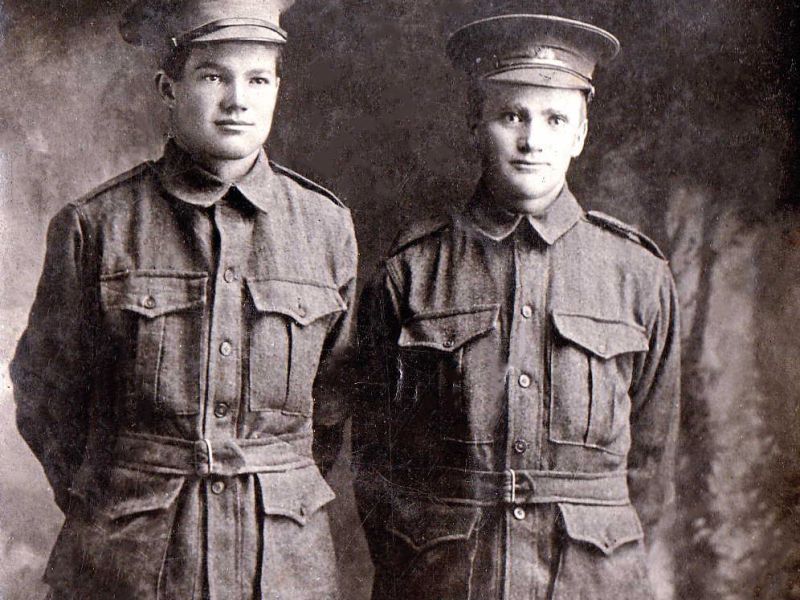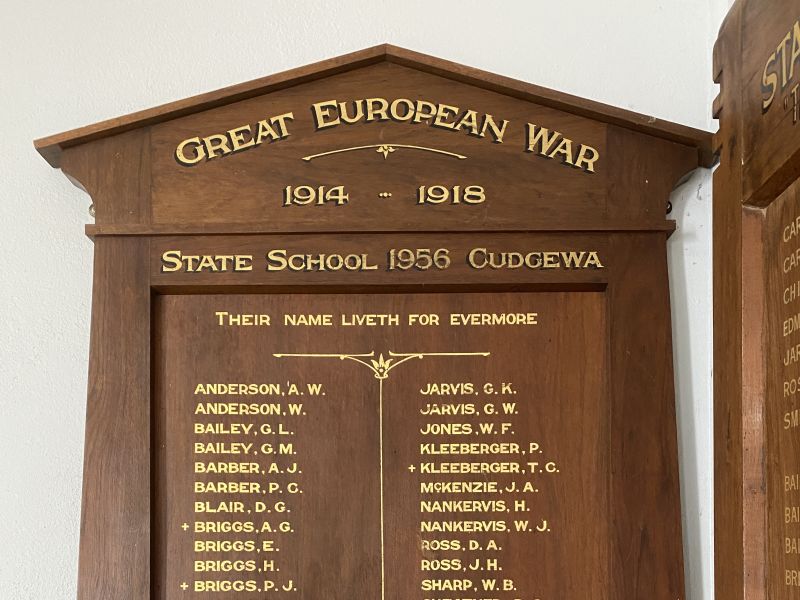Thomas Arthur (Jack) Frizzell
Jack (on the right in picture with his cousin Ernest Touzel) was born on the 27th of October 1888 at Corryong Victoria. He was the eldest of three children of Thomas Ebenezer and Martha Caroline Edwards (née Carter) Frizzell, although the youngest, Alfred, died at birth.
Jack enlisted at Broadmeadows, near Melbourne, on the 8th of September 1915. At the time he gave his address as Tambo Crossing in Gippsland and his occupation as labourer. By this time his father had passed away and his mother had remarried, settling in Gippsland with her new husband, Walter Aldridge. He listed his mother as his next of kin. Jack was allocated the Regimental Number of 3528, the rank of Private and placed into the 8th Reinforcements of the 23rd Battalion.
For the next few months Jack would undertake training at 22nd Depot Battalion, and the 4th Depot Battalion. Leave was granted and Jack headed back to Corryong along with a number of other Upper Murray boys, including; H. Taylor, F. Dugan, F. Anderson, A. Waugh, L. Coulston, G. Humphrey, J. Wheeler, N.E. Waters and R. Touzell. The 25th of November edition of the Corryong Courier reported that their leave expired on the following Tuesday, the 30th of November. Five of the above then would not return from the war, including Jack’s best mate, Rollie Touzell (on right of picture). His next posting was the 5th Depot Battalion at Seymour before finally being transferred to the Broadmeadows Camp on the 2nd of December 1915. The 8th Reinforcements of the 23rd Battalion embarked on HMAT A19 Afric at the Port of Melbourne on the 5th day of the new year, 1916.
After spending a little over one week at Moascar in Egypt and being taken on strength with his battalion, Jack proceeded to join the BEF (British Expeditionary Forces) in France, disembarking from HMT Lake Michigan at the Port of Marseilles, France on the 26th of March. The battalion travelled by train stopping at Montereau and Juvisy before detraining at Airre. A one hour march took them to their billet area in Witte, 40 km south-west of Ypres. They would remain in this area for almost two weeks, training and being used to clean up the village and local area. On the 7th of April, the 23rd Battalion moved 20 km east to the village of Sailly, a move that brought them closer to the frontline. Four days later they were at Fleurbaix, relieving the 16th Royal Scots Regiment in the frontline trenches.
For the next four months the battalion would rotate between taking their turn in the frontlines and the divisional reserve and Fort Rompu. Little rest would have been had as they would have been employed on training exercises and assisting engineers to construct defences. Whilst in the frontline they would undergo shelling from the enemy and undertake aggressive patrols, something which the Australian soldier excelled at.
In late July the 23rd Battalion participated in their first set-piece battle on French soil - the battle at Pozieres. The 23rd Battalion was part of the 6th Brigade of the 2nd Australian Division. The first mounted attack was on the 29th of July. This was a monumental failure with over 2000 casualties. The second attack which began on the 2nd of August resulted in the Division capturing German positions beyond the village. Unfortunately they suffered more heavy casualties from the German’s retaliatory bombardments. The 2nd Division’s losses over the preceding twelve days had totalled 6848 men. The 23rd Battalion alone suffered almost 90 per cent casualties.
A statement was provided by Private E. Ryan (646) of the 23rd Battalion describing what happened to Jack.
“At Pozieres in 1916 (August) the first time our Battalion was there, just as we were going ‘over the top’ three parts of the company, including myself and Private Frisell [sic], over-ran our objective by 350 yards - right on the German barbed wire. It was there that I saw Private Frisell killed by a shell.”
On the 23rd of September a Corporal C. J. Ludbrook (6486) of B Company, 6th East Yorkshire Regiment Pioneers found a body on the battlefield and, while searching it, discovered two postcards, one addressed to Jack’s sister, the other to his mother. Jack had written on the cards “Should anyone get possession of this card if I am shot, droop a few lines to the following address, she is my sister.” The Corporal did as Jack had asked and sent a short letter, along with the two cards, to Jack’s sister, May. It’s not known whether it was Jack’s body, or another soldier who had picked up the cards, or what happened to the body.
On the 2nd of August 1917 Jack’s sister placed an “In Memoriam” in the Corryong Courier.
“IN MEMORIAM
ON ACTIVE SERVICE
FRIZZELL - In loving memory of our dear brother (“Jack”) who was killed in action in France on or about 4th August, 1916. Aged 27 years.
Arthur, dear, our hearts are aching
As we think of you to-day [sic];
Sad was the hour when you left us, brother,
It seems but yesterday.
He was only a private in battle,
Just one of the rank and file;
But those left behind will remember
The day he left with a smile.
Inserted by his loving sister and brother-in-law, May and Albert Hawkins.”
Jack has no known grave but is remembered on the Villers-Bretonneux Memorial (Australian National Memorial - France). He is also remembered at the Australian War Memorial Roll of Honour, the Cudgewa Roll of Honour, the Corryong War Memorial and the . For his service during the First World War, he was awarded the British War Medal and the Victory Medal.

 Stephen Learmonth
Stephen Learmonth
